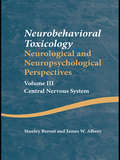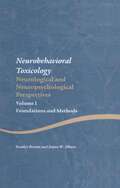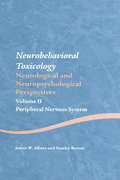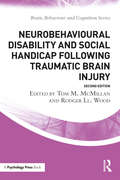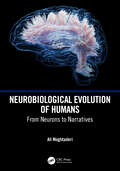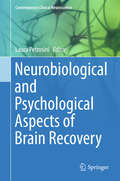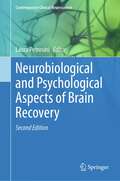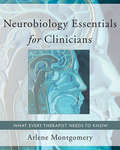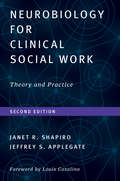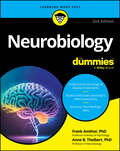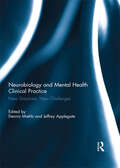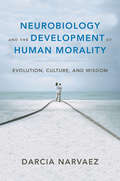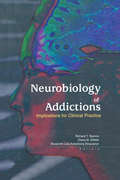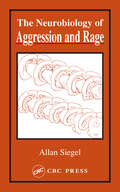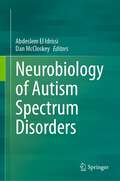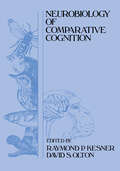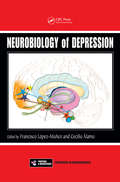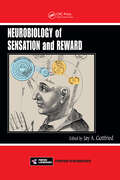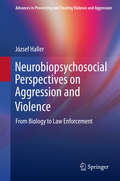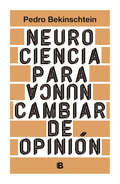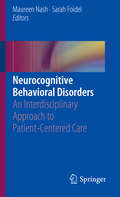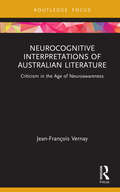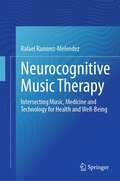- Table View
- List View
Neurobehavioral Toxicology: Central Nervous System (Studies on Neuropsychology, Neurology and Cognition)
by Stanley Berent James W. AlbersThis is the final volume in a three-volume work that has addressed the scientific methodologies relevant to clinical neurobehavioral toxicology. Volume I focused on basic concepts and methodologies in Neurobehavioral Toxicology, with Volume II focusing on the peripheral nervous system. Volume III attends to what is known about industrial and environmental chemicals, medicines, and substances of abuse and how these agents affect the central nervous system. All substances have the capacity to be toxic, depending on factors that include the physical properties of the chemical or compound, organism related variables, or interaction between the two. These substances on the other hand and as a result of these same factors might be used therapeutically or even recreationally. The difference between medicine, recreational drug, or poison depends often on a careful balance between adverse and intended effects. How to determine that a specified substance has caused harm is emphasized in the present volume by way of case examples and discussion. Illnesses and behavioral variations that compete with toxicant-induced explanations for findings in a given case, as well as the various controversies that can arise around issues of diagnosis and causal determination, are treated comprehensively in this volume.
Neurobehavioral Toxicology: Foundations and Methods (Studies on Neuropsychology, Neurology and Cognition #5)
by Stanley Berent James W. AlbersThis book, the first of three volumes, provides a thorough background to the emerging field of neurobehavioral toxicology by looking at current clinical approaches and tests, as well as assessing current clinical research. The analysis of the impact of toxins on the human nervous system is particularly pertinent given the ongoing expansion of pharmaceuticals, industrial hazards, biological warfare and global pollution. A comprehensive introduction to neurobehavioral toxicology, this work will be of interest to practicing neurologists and neuropsychologists, as well as to occupational medicine physicians and medical toxicologists.
Neurobehavioral Toxicology: Peripheral Nervous System (Studies on Neuropsychology, Neurology and Cognition #5)
by Stanley Berent James W. AlbersThis book, the second of three volumes, concentrates on peripheral nervous system disorders. Examining the effects of neurotoxicants on nerve, muscle and the neuromuscular junction, it builds on the scientific principles outlined in volume 1 by looking at the application of the methods discussed, particularly in terms of the evaluation and diagnosis of individual patients and the related process of establishing causation. Neurobehavorial Toxicology, Volume 2 will be of interest to practicing neurologists and neuropsychologists, as well as to occupational medicine physicians and medical toxicologists.
Neurobehavioural Disability and Social Handicap Following Traumatic Brain Injury (Brain, Behaviour and Cognition)
by Tom M. McMillan Rodger Ll WoodNeurobehavioural disability (NBD) follows many forms of serious brain injury and is a major constraint on social independence. This book brings together a group of leading academics and practising clinicians to provide an overview of the nature of NBD, considering how it translates into social handicap, and what can be done to address associated problems, through social and behavioural rehabilitation, vocational training and family education. This fully revised edition takes into account advances in the field, exploring the range of cognitive, emotional, and behavioural effects of brain damage most commonly associated with damage to the frontal and associated structures of the brain that govern social behaviour. This edition also features increased emphasis on psychological interventions, as well as new chapters on brain imaging, pharmacotherapy and assistive technology for disability. Neurobehavioural Disability and Social Handicap Following Traumatic Brain Injury is essential reading for clinical psychologists, psychiatrists and neurologists working in brain injury rehabilitation. The book will also be of interest to relatives of those with brain injury seeking better knowledge to understand neurobehavioural disability, as well as the growing number of therapy care assistants, case managers, support workers, and social workers responsible for the day to day care of brain injured people in the community.
Neurobiological Evolution of Humans: From Neurons to Narratives
by Ali MoghtaderiOur perception of the brain structure and function as an organ full of secrets and mysteries must change, and it is necessary to consider it as a part of the body that is constantly evolving and developing to maintain homeostasis for the entire human organism. New fossils, imaging methods, molecular genetics, comparative anatomy, evolutionary psychology, cognitive concepts in neuroscience, and neurology have made it possible to address questions of the neurological evolution of humans. This book integrates disparate findings from those disciplines in a succinct history by explaining how evolutionary process occurred, reshaped our brain, reconstructed our mind, and finally changed our "selves."Key Features Explains complex scientific concepts in neurobiology using lucid prose and maintaining a clear narrative Provides well-documented arguments supported by hundreds of references and citations Documents a complex history which unfolded over millions of years Offers new approaches intended to transform ideas, opinions, and intellectual foundations of the brain
Neurobiological and Psychological Aspects of Brain Recovery (Contemporary Clinical Neuroscience)
by Laura PetrosiniThe novelty of this book's approach lies in addressing the impact of neurobiological factors as well as psychological influences on brain recovery. There is growing evidence that emotional, motivational, and cognitive factors along with personality traits play a crucial role in brain plasticity, resilience, and recovery. Topics include synaptic and neuronal plasticity, development of brain reserves, biological markers, environmental factors, psychological profile, emotional resilience, and personality traits. By combining the latest research on neural mechanisms and on psychological resilience the authors hope that this book can lead to the development of better treatment strategies for functional recovery from brain damage.
Neurobiological and Psychological Aspects of Brain Recovery (Contemporary Clinical Neuroscience)
by Laura PetrosiniThe importance of this unique book's approach lies in addressing the impact of neurobiological factors as well as psychological influences on brain recovery following injury. There is growing evidence that emotional, motivational, and cognitive factors along with personality traits play a crucial role in brain plasticity, resilience, and recovery. Topics include synaptic and neuronal plasticity, development of brain reserves, biological markers, environmental factors, emotional resilience, and personality traits. By combining the latest research on neural mechanisms and psychological resilience the authors present a book that will help lead to the development of better treatment strategies for functional recovery from brain damage. The new edition is fully updated throughout and contains completely new chapters on brain recovery in childhood, epigenetic aspects of brain recovery, and artificial intelligence techniques in traumatic brain injury research.
Neurobiologically Informed Trauma Therapy with Children and Adolescents: Understanding Mechanisms of Change (Norton Series on Interpersonal Neurobiology)
by Linda ChapmanNonverbal interactions are applied to trauma treatment for more effective results. The model of treatment developed here is grounded in the physical, psychological, and cognitive reactions children have to traumatic experiences and the consequences of those experiences. The approach to treatment utilizes the integrative capacity of the brain to create a self, foster insight, and produce change. Treatment strategies are based on cutting-edge understanding of neurobiology, the development of the brain, and the storage and retrieval of traumatic memory. Case vignettes illustrate specific examples of the reactions of children, families, and teens to acute and repeated exposure to traumatic events. Also presented is the most recent knowledge of the role of the right hemisphere (RH) in development and therapy. Right brain communication, and how to recognize the non-verbal symbolic and unconscious, affective processes will be explained, along with examples of how the therapist can utilize art making, media, tools, and self to engage in a two-person biology.
Neurobiology Essentials for Clinicians: What Every Therapist Needs to Know
by Arlene Montgomery Allan N. SchoreThis book presents an overview of the latest theories of affect regulation and focuses on how these theories work in clinical settings and how therapists can be taught to implement them. The notion of teaching and learning will be extended by the theories themselves-the author presents methods of education that enact the theories being taught. The book is divided into eight chapters, each one highlighting a particular structure or related structures of the brain. Suggestions for learning how to clinically apply the neurobiological/neuroanatomical information are offered. What is so unique about this book is that the bulk of the chapters are clinical dialogue, accompanied by neurobiological commentary. Thus, readers can see for themselves, during the course of parts of sessions, just how a "neurobiological outlook" can inform therapeutic understandings of what clients are doing and saying. The result is a very user-friendly learning experience for readers, as they are taken along a journey of understanding various brain systems and how they relate to psychotherapeutic principles. Elegantly bridging the gap between the academic and clinical domains, this book is essential for anyone interested in the application of neurobiological principles to psychotherapy and wishes to learn about neurobiology without feeling overwhelmed or intimidated.
Neurobiology Essentials for Clinicians: What Every Therapist Needs to Know (Norton Series on Interpersonal Neurobiology)
by Arlene Montgomery Allan N. SchoreA primer on brain functionality as it relates to therapeutic work. This book presents an overview of the latest theories of affect regulation and focuses on how these theories work in clinical settings and how therapists can be taught to implement them. The notion of teaching and learning will be extended by the theories themselves--the author presents methods of education that enact the theories being taught. The book is divided into eight chapters, each one highlighting a particular structure or related structures of the brain. Suggestions for learning how to clinically apply the neurobiological/neuroanatomical information are offered. What is so unique about this book is that the bulk of the chapters are clinical dialogue, accompanied by neurobiological commentary. Thus, readers can see for themselves, during the course of parts of sessions, just how a "neurobiological outlook" can inform therapeutic understandings of what clients are doing and saying. The result is a very user-friendly learning experience for readers, as they are taken along a journey of understanding various brain systems and how they relate to psychotherapeutic principles. Elegantly bridging the gap between the academic and clinical domains, this book is essential for anyone interested in the application of neurobiological principles to psychotherapy and wishes to learn about neurobiology without feeling overwhelmed or intimidated.
Neurobiology For Clinical Social Work, Second Edition: Theory And Practice (Norton Series On Interpersonal Neurobiology Ser. #0)
by Jeffrey S. Applegate Janet R. ShapiroDemystifying neurobiology and presenting it anew for the social-work audience. The art and science of relationship are at the core of clinical social work. Research in neurobiology adds a new layer to our understanding of the protective benefits of relationship and specifically, to our understanding of the neurobiology of attachment and early brain development. This second edition of Neurobiology for Clinical Social Work explores the application of recent research in neuroscience to prevention and intervention in multiple systems, settings, and areas such as the neurobiology of stress and the stress response system, the impact of early adversity and toxic stress on brain development, early childhood and adolescent brain development, and the application of this science to prevention and intervention in areas such as child welfare and juvenile justice. Social workers collaborate with individuals, families, communities, and groups that experience adversity, and at times, traumatic stressors. Research in neuroscience adds to our models of risk and resilience; informing our understanding of the processes by which adversity and trauma impact multiple indicators of wellbeing across time. Social workers can use this knowledge to inform their work and to support the neuroprotective benefit of relationship in the lives of individuals, families, and communities. This text provides essential information for cutting-edge social work practice.
Neurobiology For Dummies
by Frank Amthor Anne B. TheibertAn essential guide to help you demystify the complex topic of neurobiology and jump into this fascinating scientific field Neurobiology is a notoriously difficult subject, but Neurobiology For Dummies explains the essentials in terms anyone can understand. This fun and accessible book covers the fundamentals, covering the anatomy, physiology, and pathology of the nervous system. Students in fields like neuroscience and pharmacology will get a complete overview of the molecular and cellular mechanisms of the nervous system, making it easier to complete coursework and pass exams in introductory neurobiology courses. In this updated edition, fresh examples highlight the latest research, so you'll be prepared with a current understanding of the science. Whatever your ultimate career destination, this Dummies guide will help you get neurobiology under your belt. Get easy-to-understand explanations of complex topics in neurobiology Understand the latest breakthroughs in neurological disease treatments Learn about the fascinating ways that the brain and body are interconnected Supplement your neurobiology textbook and prepare for your exam This is the perfect resource for students majoring in neuroscience, biology, cognitive science, medicine, and beyond. With Neurobiology For Dummies as a supplement, you can sail through any introductory neurobiology course.
Neurobiology and Mental Health Clinical Practice: New Directions, New Challenges
by Dennis Miehls and Jeffrey ApplegateThis book illustrates the current findings of interpersonal neurobiology that inform knowledge building and clinical practice. Contributions cover an impressive range of material including how neurobiology interfaces with clinical work with children, individuals with substance abuse issues, couples and clients with trauma histories. Leading mental health clinician-scholars describe path-breaking explorations at the neurobiological frontiers of 21st century clinical theory and practice. Representing the fields of social work, psychology and psychiatry, these authors creatively apply research findings from the ongoing revolution in social and behaviour neuroscience to a diverse array of clinical issues. Contributions include elaborations of theory (the evolving social brain; new directions in attachment, affect regulation and trauma studies); practice (neurobiologically informed work with children, adults, couples and in the conduct of supervision); and emerging neuroscientific perspectives on broader mental health issues and concerns (substance abuse; psychotropic medications; secondary traumatic stress in clinicians; the neurodynamics of racial prejudice; the dangers of forfeiting humanism to our current romance with the biological). Together, these chapters equip readers with state-of-the-art knowledge of the manner in which new understandings of the brain inform and shape today’s professional efforts to heal the troubled mind. This book was originally published as a special issue of Smith College Studies in Social Work.
Neurobiology and the Development of Human Morality: Evolution, Culture, and Wisdom (Norton Series on Interpersonal Neurobiology)
by Allan N. Schore Darcia NarvaezA wide-ranging exploration of the role of childhood experiences in adult morality. Moral development has traditionally been considered a matter of reasoning--of learning and acting in accordance with abstract rules. On this model, largely taken for granted in modern societies, acts of selfishness, aggression, and ecological mindlessness are failures of will, moral problems that can be solved by acting in accordance with a higher rationality. But both ancient philosophy and recent scientific scholarship emphasize implicit systems, such as action schemas and perceptual filters that guide behavior and shape human development. In this integrative book, Darcia Narvaez argues that morality goes "all the way down" into our neurobiological and emotional development, and that a person's moral architecture is largely established early on in life. Moral rationality and virtue emerge "bottom up" from lived experience, so it matters what that experience is. Bringing together deep anthropological history, ethical philosophy, and contemporary neurobiological science, she demonstrates where modern industrialized societies have fallen away from the cultural practices that made us human in the first place. Neurobiology and the Development of Human Morality advances the field of developmental moral psychology in three key ways. First, it provides an evolutionary framework for early childhood experience grounded in developmental systems theory, encompassing not only genes but a wide array of environmental and epigenetic factors. Second, it proposes a neurobiological basis for the development of moral sensibilities and cognition, describing ethical functioning at multiple levels of complexity and context before turning to a theory of the emergence of wisdom. Finally, it embraces the sociocultural orientations of our ancestors and cousins in small-band hunter-gatherer societies--the norm for 99% of human history--for a re-envisioning of moral life, from the way we value and organize child raising to how we might frame a response to human-made global ecological collapse. Integrating the latest scholarship in clinical sciences and positive psychology, Narvaez proposes a developmentally informed ecological and ethical sensibility as a way to self-author and revise the ways we think about parenting and sociality. The techniques she describes point towards an alternative vision of moral development and flourishing, one that synthesizes traditional models of executive, top-down wisdom with "primal" wisdom built by multiple systems of biological and cultural influence from the ground up.
Neurobiology of Addictions: Implications for Clinical Practice
by Diana M. Dinitto Shulamith L Straussner Richard T. SpenceBridge the gap between the physical foundations of substance abuse and the psychosocial approaches that can treat it!This groundbreaking book offers helping professionals a thorough introduction to the neurobiological aspects of substance abuse. It presents the basic information on the subject, including the various neurobiological theories of addiction, and places them in a psychosocial context. Its clear and straightforward style connects the theoretical information with practical applications. This is an essential resource for substance abuse counselors, researchers, therapists, and social workers. Neurobiology of Addictions offers sound, tested information on substance abuse issues, including: neurobiological theories of addiction integrating drug treatments and therapeutic interventions using neurobiology to discover substance abuse in clients of various ages perspectives from social work, pharmacology, biology, and neuroscience
Neurobiology of Aggression and Rage
by Allan SiegelWhile other books concentrate on the different facets of aggression, these publications tend to focus on a single aspect of the subject and do not make any attempt to integrate biology and behavior. This lack of integration in the literature has created a major gap in our current understanding of the factors that influence aggressive actions. <
Neurobiology of Autism Spectrum Disorders
by Abdeslem El Idrissi Dan McCloskeyThis book brings together the exciting new findings that will bring us closer to a better understanding of the alterations of neuronal connectivity in autistic brains. This volume authoritatively covers the epidemiology, physiology, neurodevelopment, genetics, environmental influences, imaging studies, neuroanatomy, and neurochemistry of autism spectrum disorders. While the neurobiology of autism is still a long way from being understood, this book posits techniques, such as using brain imaging to find signatures in early days of life, that could help move the diagnosis and help identify neural pathways. Understanding these mechanisms opens the possibility to pharmacological, behavioral, and psychosocial therapeutic interventions. With contributions from the leading international autism researchers, Neurobiology of Autism Spectrum Disorders is the go-to reference for researchers and clinicians with an interest in understanding the underlying neurobiology of autism spectrum disorders.
Neurobiology of Comparative Cognition (Comparative Cognition and Neuroscience Series)
by Raymond P. Kesner David S. OltonThis book represents a unique and elaborate exposition of the neural organization of language, memory, and spatial perception in a wide variety of species including humans, bees, fish, rodents, and monkeys. The editors have united the comparative approach with its emphasis on evolutionary determinants of behavior, the neurobiological approach with its emphasis on the neural determinants of behavior, and the cognitive approach with its emphasis on understanding higher-order mental functions. The combination of these three approaches provides an unusual look at the neurobiology of comparative cognition, and should stimulate increased investigations in this field and related disciplines.
Neurobiology of Depression (Frontiers in Neuroscience)
by Cecilio Álamo Francisco López-MunozMajor depressive disorders have recently been associated with impairments in signaling pathways that regulate neuroplasticity and cell survival. Agents designed to directly target molecules in these pathways hold promise as new therapeutics for depression. With the collaboration of the most prestigious international specialists in biochemistry, mol
Neurobiology of Sensation and Reward
by Jay A. GottfriedSynthesizing coverage of sensation and reward into a comprehensive systems overview, Neurobiology of Sensation and Reward presents a cutting-edge and multidisciplinary approach to the interplay of sensory and reward processing in the brain. While over the past 70 years these areas have drifted apart, this book makes a case for reuniting sensation a
Neurobiopsychosocial Perspectives on Aggression and Violence: From Biology to Law Enforcement (Advances in Preventing and Treating Violence and Aggression)
by József HallerThis book bridges the gap between basic science, which deals with general concepts of aggression and its neurobiological foundations, and law enforcement as one of the applied fields of aggression research. It addresses the current state of research and practice and compares and integrates the concept of aggression with violent crime. Chapters examine the types of criminal careers that cross the boundary between the two and summarize the biological, psychological, and social factors that underlie particular types of criminal careers. Subsequent chapters discuss overlaps between biological and psychological factors and detail how and to what extent aggression may serve as explanatory mechanisms for violence. The book also discusses the relationship between social problems and neuropsychological deficits, addressing how the neuropsychological deficits lead to the intergenerational recycling of social problems. Finally, the volume explores violence and aggression from a neurobiological perspective. Topics featured in this book include:The heritability of aggressiveness and violence-proneness.Glucocorticoids in humans.Aggression circuitry in animals.Distorted circuitry in violent animals.Biological factors of psychological change. Neurobiopsychosocial Perspectives on Aggression and Violence is a must-have resource for researchers, clinicians and other professionals, and graduate students in forensic psychology, criminology/criminal justice, public health, developmental psychology, psychotherapy/counseling, psychiatry, social work, educational policy and politics, health psychology, nursing, and behavioral therapy/rehabilitation.
Neurociencia para (nunca) cambiar de opinión
by Pedro BekinschteinEste libro intenta recorrer algunos de los mecanismos psicológicos y cognitivos involucrados en la resistencia al cambio de visión. Las preguntas irán desde cómo nuestras expectativas y creencias afectan la manera en la que percibimos el mundo hasta si existen bases biológicas que expliquen las diferencias en ideología política. Somos capaces de discutir por las cosas más banales y las más profundas como, por ejemplo, si son mejores los perros o los gatos, si es mejor el invierno o el verano, si la marihuana debe ser legal o no, si pinot noir o cabernet, si paridad de género o meritocracia, si es más rico el helado de agua o el de crema, si el alma existe o si es una creación de las religiones, y así podría hacer un libro entero sobre las grietas. (Y sobre cuánto nos gusta tener razón.) Probablemente la mayoría tenga una opinión sobre muchos de esos temas. Estos juicios crecen como malezas sobre nuestro suelo fértil de creencias y van ocupando la capacidad de decidir según las evidencias. Las opiniones no se llevan muy bien con las evidencias cuando estas no coinciden. Este libro intenta recorrer algunos de los mecanismos psicológicos y cognitivos involucrados en la resistencia al cambio de visión. Las preguntas irán desde cómo nuestras expectativas y convicciones afectan la manera en la que percibimos el mundo y recordamos las experiencias colectivas hasta si existen bases biológicas que expliquen las diferencias en las ideologías políticas. Pedro Bekinschtein, doctor en biología, se cuestiona, por ejemplo, si nuestras decisiones a la hora de votar representantes están basadas en sus propuestas o en aspectos más misteriosos e indescifrables que ocurren fuera de nuestra conciencia. En estas páginas vibrantes que encastran a la perfección ciencia y actualidad, nos invita a descubrir qué nos pasa cuando no podemos cambiar de opinión, lo que él llama "la necedad del cerebro".
Neurocognitive Behavioral Disorders: An Interdisciplinary Approach to Patient-Centered Care
by Maureen Nash Sarah FoidelDementia, now known as major neurocognitive disorder, is not one monolithic disease. Nor is behavior disturbance driven by one particular neurocognitive dysfunction. In fact if we are able to understand it, behavior is an excellent form of nonverbal communication. There are many different causes of dementia. A major challenge with both researching and implementing interventions is viewing dementia and related behaviors as single entities. This approach leaves room for critical errors in the treatment of dementia patients, beginning with misdiagnosis. This book approaches dementia by reviewing cognitive and functional assessments to provide a more accurate diagnosis, which then allows physicians to design specific interventions that are tailored to the person and their challenges. Because person centered care is vital to quality of life and longevity to an aging patient, this understanding of individual needs is vital. Written by experts in the field, this book incorporates the latest evidence-based behavioral interventions matched to specific deficits. Behavioral management focuses not on controlling behavior, but using it to teach staff and caregivers how to interpret common actions and maximize function for people with major neurocognitive disorders. Quality of life and individualized care planning will be the theme and the book will provide practical case examples. The book begins by introducing dementia and other neurocognitive illnesses, contextualizing them both historically and contemporarily. Next, the text focuses on the comprehensive assessment of a person with neurocognitive challenges in order to identify strengths and understand what the person is trying to communicate with their behavior. This process allows individualized care planning and behavioral (non-pharmacologic) management to meet the cognitive challenges and maximize individual strengths and thereby improve outcomes, making this a cutting edge resource.
Neurocognitive Interpretations of Australian Literature: Criticism in the Age of Neuroawareness (Routledge Focus on Literature)
by Jean-François VernayThis unique book on neurocognitive interpretations of Australian literature covers a wide range of analyses by discussing Australian Literary Studies, Aboriginal literary texts, women writers, ethnic writing, bestsellers, neurodivergence fiction, emerging as well as high- profile writers, literary hoaxes and controversies, book culture, and LGBTIQA+ authors, to name a few. It eclectically brings together a wide gamut of cognitive concepts and literary genres at the intersection of Australian literary studies and cognitive literary studies in the first single-author volume of its kind. It takes Australian Literary Studies into the age of neuroawareness and provides new pathways in contemporary criticism.
Neurocognitive Music Therapy: Intersecting Music, Medicine and Technology for Health and Well-Being
by Rafael Ramírez-MeléndezFor thousands of years, music has acted as a powerful medium for evoking emotions, facilitating communication, and nurturing overall well-being. With the advent of new sophisticated neuroimaging technology, human responses to music and music therapy are being viewed through a new lens. As a consequence, new knowledge is being obtained about how music can produce significant improvements in cognitive, social, overt and agitated behaviours. The aim of this book is to provide an overview of neurocognitive music therapy, its impact and implications in the practice of evidence-based music interventions. The book seeks to provide researchers, psychologists, music therapists, musicians and physicians interested in the therapeutic applications of music, with a source of information about current techniques and novel music interventions. It is structured into several chapters, each of them presenting peer-reviewed research and evidence-based procedures carried out in a specific clinical context. Topics covered in the book include: Musical engagement for individuals with motor disabilities Enhancing emotional processing in autism through music Stroke rehabilitation via musical interventions Musical neurofeedback for emotional disorders Emotional modulation with music therapy in palliative care AI-driven personalisation in music interventionsThe book highlights the profound capacity of music-based interventions to facilitate cognitive and emotional processing, enhance communication, and promote motor rehabilitation. At the same time, the book demonstrates how modern technologies offer new opportunities to evaluate, validate, and potentiate music-based interventions, allowing new and innovative possibilities and more personalised interventions. This book aims to contribute to the growing body of knowledge in this field and inspire further research and innovation in the practice of music therapy.
